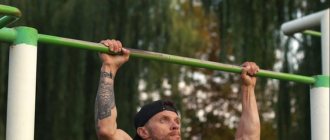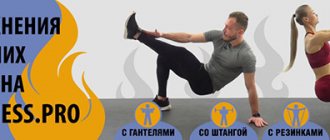Fitness and BodybuildingTips and Tricks
Do low rep sets really build strength? What about high rep sets? Is pumping useful for pumping up muscles? In this article we will answer all your questions regarding the number of repetitions.
Author:
Cliff Wilson
I remember the first time in my life I picked up a bodybuilding magazine. I was interested in how to properly train and build muscles. A complete layman in iron sports at that time, I was ready to absorb, like a sponge, any information from the magazine. It contained an article about the training of a professional bodybuilder (IFBB member), whose name makes no sense. The article described this athlete's favorite training program and the reasons why he liked it.
In one phrase I found the answer to the question that interested me. This bodybuilder said: “When I'm bulking, I lift heavy weights for low reps, and when it's time to cut, I lift light weights for high reps. This is the best way to burn fat." I decided that this was true, because the guy was big and prominent.
In the process of getting to know the world of bodybuilding, I have heard this “truth” more than once. Having an inquisitive mind and a thirst for knowledge, I soon discovered that the common statement about a small number of repetitions for mass and a large number for relief is very far from reality. As it turns out, in bodybuilding circles the truth about the number of repetitions is shrouded in darkness.
I have experience working with clients of varying fitness levels. Some of them seriously trained and competed, others were just starting their journey in the world of bodybuilding. I was surprised to notice that all my students, despite their level of training, misunderstood this simple question.
It's time to end this! I want to put everything in its place. Perhaps what I am about to tell you now will not become a sensation for experienced bodybuilders. However, everyone who steps into the gym should know this.
Low reps
Low reps include approaches consisting of 1-5 repetitions. It is believed that low-rep sets use fast-twitch muscle fibers, while high-rep sets use slow-twitch muscle fibers. Another misconception about the number of repetitions. In fact, low-rep sets work ALL muscle fibers - from slow to fast (including intermediate ones).
The body recruits muscle fibers (slow - intermediate - fast) as needed. When a muscle is under load, the slow muscle fibers are the first to engage. If slow-twitch fibers fail to develop enough force to lift a weight, intermediate fibers assist.
If slow and intermediate muscle fibers cannot cope with the load or become tired, the body mobilizes fast fibers. Muscle fibers are not partially or half used. The muscle fiber contracts at its maximum amplitude (Saladin, 2007). That is, when working with heavy weights, both slow and intermediate muscle fibers receive load.
In addition, low-repetition sets are effective in stimulating myofiber hypertrophy.
Myofibril hypertrophy
is an increase in the number and size of actin and myosin filaments in muscle tissue. Due to an increase in the number of tissues capable of contraction, this type of hypertrophy is characterized by an increase in strength indicators (Zatsiorski, 2006). This is an important point because consistently increasing weights is the main factor in building muscle mass in the long term. As you can see, performing low-repetition approaches with heavy weights is the key to huge muscles.
The number and speed of repetitions for the development of various physical qualities[edit | edit code]
Source: "Training Programs"
, scientific ed.
Author:
Professor, Doctor of Science Tudor Bompa, 2020
Speed, or time, of repetitions
is an important load parameter during strength training, which is not always used correctly. For example, there is a common belief in bodybuilding circles that lifting weights should be done slowly when lifting above 85 percent of your RM, but in reality this is not strictly necessary. Strength athletes who develop explosive lifting can quickly lift loads up to 95 percent of their rep max and demonstrate high levels of energy production even under such high loads.
The whole point is to train the nervous system to activate all motor units within the shortest possible period of time. This effect is achieved by periodizing the strength training program and moving from intermuscular coordination training (explosive work under moderate to high load) to intramuscular coordination training (explosive work under maximum load or at least an attempt at explosive work)[11]. See the table in the article Adaptation to physical activity.
To develop maximal strength (i.e., working at 70 to 100 percent of your rep max), the number of repetitions should be low (one to five); see table 8 in the article Gradual increase in load. For power-building exercises (i.e., working at 50 to 80 percent of your rep max), the number of repetitions should be low to moderate (one to 10 dynamic repetitions). For short-term muscular endurance, 10 to 30 repetitions are appropriate, while medium-term muscular endurance requires 30 to 60 continuous repetitions, and long-term muscular endurance requires even more repetitions of up to 200. The number of repetitions suggested may be shocking. trainers who believe that 20 repetitions is enough to develop muscular endurance. However, performing 20 repetitions has little effect on overall performance in sports that require mid- to long-term muscular endurance, such as rowing, kayaking, canoeing, long-distance swimming, and cross-country skiing.
Table 1 shows the relationship between load and possible number of repetitions performed to failure by two different types of athletes. It also follows from this table that RM conversion tables are practically useless, since they do not take into account the individual characteristics of the athlete, who may be at one of the extremes of the neuro-metabolic range.
Table 1. Correlation between percentage rep max and possible number of repetitions to failure for athletes with a neuromuscular advantage and athletes with a metabolic advantage
| An athlete with a high level of neuromuscular efficiency (power) | Athlete with a high level of metabolic efficiency (endurance) | |
| %repetition max | Repetitions | Repetitions |
| 100 | 1 | 1 |
| 95 | 1-2 | 2-3 |
| 90 | 3 | 4-5 |
| 85 | 5 | 6-8 |
| 80 | 6 | 10-12 |
| 75 | 8 | 15-20 |
| 70 | 10 | 25-30 |
| 65 | 15 | 40-50 |
| 60 | 20 | 70-90 |
| 50 | 25-30 | 90-110 |
| 40 | 40-50 | 120-150 |
| 30 | 70-100 | 150-200 |
Speed is an important factor in strength training. To achieve maximum effect, the speed of repetitions must be high and explosive for most exercises, at least for the concentric phase. Proper use of speed involves the athlete applying force against resistance. For example, when an American football player, thrower, or sprinter is working under a high load (above 90% of the rep max), the movement may appear slow, but the force being applied against the resistance is as fast as possible. Otherwise, the nervous system does not recruit and activate at maximum frequency all the motor units necessary to overcome resistance. Only through the rapid and vigorous application of force does training occur to intentionally engage the fibers of fast-twitch muscles. Strictly speaking, according to the results of recent studies that looked at performing a concentric weight lifting effort at the maximum expected speed and at half the speed, performing the lift at maximum speed for six weeks resulted in twice the increase in maximum strength compared to the increase in maximum. strength when slowly lifting weights, and the speed of work increases under any load[12].
For this reason, muscle contraction speed plays a very important role in strength training. In order to achieve explosive force, the athlete must concentrate on rapidly activating the muscles, even when the barbell is moving slowly. Although most of the time the bar should be moving quickly. Fast twitch fibers are instantly recruited only at high contraction speeds under heavy load (above 70 percent RM), resulting in increased maximal strength and power.
The timing of repetitions also has a significant impact on the physiological response during strength training, and this factor is directly related to the length of time the muscles are under tension during the set; see table 2. Accordingly, the speed of movement should vary, depending on the stage of training. Table 3 shows the repetition times for each phase of the strength training program.
At a moderate speed of the concentric phase, metabolic tension and expression of muscle force throughout the range of motion increases, and such speed can be used to enhance the hypertrophic response to training. Moderate speed is used during the anatomical adaptation phase because in this situation the athlete has better control of the movement and the muscles are under pressure for a longer period of time. The eccentric portion of the weight lift can last for three to four seconds, followed by a one-second pause to transition from the eccentric to the concentric phase, and then two seconds during the concentric phase. However, throughout the remainder of the annual plan, athletes should perform the concentric phase of strength training in a high-velocity, explosive manner, as most sports require rapid concentric contractions.
The desired contraction velocity should be as high as possible during the phases where the focus is on maximum strength, power, strength endurance and short-term muscular endurance. During the maximal strength phase, athletes should perform three to four eccentric actions slowly, followed by an explosive concentric action. At this stage, the athlete can control the transition from eccentric to concentric action. In fact, the best way to maximize concentric strength is to remove any reflex or flexibility characteristics developed during the eccentric phase of the weight lift by pausing for one to two seconds before performing the concentric phase. These techniques should be used early in the maximal strength training phase.
Table 2. Training results according to changes in repetition time
| MUSCLE ACTION | ECCENTRIC PHASE | ISOMETRIC PHASE BETWEEN ECCENTRIC AND CONCENTRIC PHASES | CONCENTRIC PHASE | ISOMETRIC PHASE BETWEEN CONCENTRIC AND ECCENTRIC PHASES | ||||
| TIME PERFORMANCE | Slow (3-5 sec.) | Fast (<1 sec.) | Absent | Present (1-5 sec.) | Slow (2-3 sec.) | Fast (<1 sec.) | Absent | Present (1-2 sec.) |
| EFFECT WORKOUT | Promotion hypertrophy | Decline hypertrophy | Decline hypertrophy | Increased hypertrophy | Promotion hypertrophy | Promotion Max. strength | Promotion metabolic voltage | Increased activation of fast twitch fibers |
| Increased max, strength | Promotion cyclical starting strength | Increased cyclic starting strength | Increased acyclic starting force | Promotion metabolic voltage | Promotion nervous voltage | |||
Table 3: Suggested rep times by stage of training
| Eccentric phase | Isometric phase between eccentric and concentric phases | Concentric phase | Isometric phase between eccentric and concentric phases | Example of suggested runtime | |
| AA | Slow | Present | Slow or fast | Absent | 3.0.2.0 |
| Hyp. | Slow | Present or absent | Fast | Absent | 4.1.1.0 |
| MS | Slow | Present or absent | Fast | Absent or present | 3.0.Х.1 |
| M | Fast | Absent (cyclic), present (acyclic) | Fast | Absent or present | 1.0.X.0 |
| NE | Fast | Absent (cyclic), present (acyclic) | Fast | Absent | 1.0.X.0 |
| CMS | Fast | Absent | Fast | Absent | 1.0.1.0 |
| SMV | Moderate | Absent | Fast | Absent | 2.0.1.0 |
| DMV | Moderate | Absent | Moderate | Absent | 2.0.1.0 |
Legend: AA - anatomical adaptation, Hyp. - hypertrophy, DMV - long-term muscular endurance, SMV - medium-term muscular endurance, CMV - short-term muscular endurance, MS - maximum strength, M - power and SV - strength endurance.
As an example, consider the bench press. When performing this exercise, the concentric part consists of extending the arms, and returning the bar to chest level and stretching the chest muscles is the eccentric part. In a simplified way, the exercise is the following sequence: the athlete slowly bends his arms to bring the barbell closer to his chest, after which he quickly returns it to its starting position and starts the cycle all over again. On the other hand, the eccentric part of the work can increase the strength of the subsequent concentric part if the eccentric part is also performed quickly, resulting in the so-called myotatic reflex. This reflex is the reason why plyometric training is especially popular in sports. Essentially, plyometric training results in improved athlete performance by improving the physiological properties of the prime mover muscles to perform fast and explosive concentric actions.
When an athlete quickly lowers the barbell to the chest, neural mechanisms in the muscles are activated and elastic energy is stored in the ligaments for use during the concentric or lifting phase of the barbell. Thus, a net increase in concentric force generation can be achieved by pausing after the eccentric phase, thereby eliminating the positive effect of the eccentric phase. This approach makes it possible to standardize the range of motion of each repetition and does not allow the athlete to cheat and push the weight. As a result, due to improved execution technique, intermuscular coordination improves.
This approach can also be used to help an athlete overcome a training plateau. The coach must determine the priority, which may be deliberate maximization of concentric strength or imitation of a specific neuromuscular algorithm (usually an action that includes an eccentric and concentric phase). Ultimately, at the stage of maximum strength, priority should be given not to the first, but to the second.
Rep time is directly related to the duration of the set and represents the interval during which the muscles are under tension during a repetition. If you multiply this period of time by the number of repetitions, you can determine the total duration of the approach. For each stage of training, there is an optimal way to perform each repetition, depending on the training effect that is the goal of that stage. This specificity also applies to the duration of the approach, which depends on the body’s energy system involved. Table 4 shows the training effect for various set durations.
Table 4. Duration of approach and training results
| Duration of approach | Training effect |
| 2-12 seconds | Increased strength without gains in hypertrophy (relative strength) or power |
| 15-25 seconds | Increased strength with increased hypertrophy (absolute strength) |
| 30-60 seconds | Hypertrophy |
| 6-15 seconds (series of approaches) 15-30 seconds (approaches) | Strength endurance |
| 15-60 seconds (series of approaches) 30-120 seconds (approaches) | Short-term muscular endurance |
| 1-4 minutes (series of approaches) 2-8 minutes (sets) | Medium-term muscular endurance |
| Over 8 minutes | Long-term muscular endurance |
Average number of repetitions
This includes sets of 6-12 repetitions. A number of scientific studies confirm the fact that the average number of repetitions helps to increase muscle size. The effectiveness of approaches with a medium number of repetitions is explained simply - they are universal.
In other words, it combines the benefits of both low-rep and high-rep sets. Muscles have to work with relatively larger weights, spending more time under load. Heavy weights stimulate the synthesis of myofibrillar proteins, which, as mentioned above, lead to an increase in the size of contractile proteins. Increasing the time under load activates sarcoplasmic hypertrophy.
Sarcoplasmic hypertrophy
is an increase in the volume of sarcoplasm and the size of supporting proteins in muscle cells that occurs as a result of lifting light weights for high repetitions. This type of muscle growth (which typically does not involve an increase in strength) explains why bodybuilders look more toned compared to powerlifters and strength athletes.
Medium rep training also produces excellent muscle pumps. Despite the fact that pumping is usually considered as a short-term effect of training, there is a possibility of its effect on increasing muscle mass. The results of scientific research show that an increase in cell size leads to both an increase in the rate of protein synthesis and a decrease in the rate of their breakdown.
So, while low-rep sets with heavy weights best stimulate myofibril hypertrophy, and high-rep sets with light weights best stimulate sarcoplasmic hypertrophy, then medium-rep sets occupy the “sweet spot” - they provide hypertrophy of both myofibers and sarcoplasm. Given the scientific facts, it is extremely unwise to eliminate medium-rep sets from your training program.
How many repetitions and approaches should I do?
Let's now talk in more detail about each case of performing an approach to mass, strength, endurance or relief, but before that, let's introduce the concepts of basic terms .
Repetition (repetition) is the execution of a movement alternately in two opposite directions, that is, first in the phase of eccentric contraction (the muscle lengthens), and then in the phase of concentric contraction (shortening the muscle). And if it’s very simple, then a repetition is a one-time exercise, that is, one time .
An approach is performing without rest (without stopping) several repetitions in a row (from one and above).
How many repetitions and approaches to do
Set time is the time it takes to complete repetitions in one set.
For strength (increasing strength indicators)
One of the main tasks and goals of many athletes in various sports is to increase strength indicators, which are often the prevailing factor in victory in speed-strength sports. For example, if you are a sprinter , then strength indicators are more important to you, and if you are a stayer , then endurance, based on this you need to build your training process.
In bodybuilding , approaches to increase muscle mass also increase strength, but not at all as pronounced as if you were performing an approach with an emphasis on increasing strength indicators.
Training for strength means performing an exercise for a small number of repetitions from 1 to 5 times , in this given number of repetitions the muscles will be under load for about 2-25 seconds , which means active consumption of creatine (remember the energy supply of muscle activity) and training of fast muscle fibers (myofibrillar hypertrophy).
Accordingly, the more intense the training, the more and faster creatine is consumed in the body. That is why if your goal is to increase strength, then it is advisable to combine your training with taking creatine supplements.
Perform strength approaches
Creatine is a natural compound formed in the body from three amino acids (methionine, arginine and glycine), which is involved in energy metabolism and is consumed in large quantities during active physical work for a maximum of the first 2 minutes , then other energy sources (glycogen, fats) are connected.
Thus, strength training - with a small number of repetitions in approaches, actively stimulates the growth of contractile proteins (the main ones are myosin, actin, actomyosin, tropomyosin, troponin, b- and b-actinins)
When training, it is important to select such a weight on the bar/simulator so that you enter a given range of the number of repetitions, in this case from one to five, that is, after the fifth repetition you should experience failure (or almost muscle failure). If, for example, you did 5 repetitions and finished the set, but you yourself feel that you could still do 3-4 repetitions from above, then increase the working weight - you should have enough strength for clearly 5 repetitions (or less if you do 2 -4). Otherwise, your training cannot be considered full-fledged for strength, but rather for mass with an underload .
For mass (increasing muscle volume)
Approaches performed for mass in bodybuilding must lie strictly within the range
8-12 reps , which corresponds to approximately 80% of your maximum weight lifted in the exercise. It is with this type of training that strength exercises can bring you significant success in hypertrophy (increase) muscle mass.
8-12 rep sets are very popular in gyms among bodybuilders, and for good reason. A very long time ago, when experiments had not yet been carried out on the effectiveness of one or another training option, bodybuilders found out empirically that the 8-12 repetition range grows muscles very well (for example, remember the words of Tom Platz, who, responding at his seminar , said that many things in He learned about bodybuilding through experience, and only then read studies that confirmed his effective training). This happened with the number of repetitions, Tom Platz came to the conclusion: 8-12 repetitions best increase muscle mass, but only later these data were confirmed by scientists (link to one of the studies in 2008 https://physoc.onlinelibrary.wiley.com /doi/full/10.1113/jphysiol.2008.164483, which states that protein synthesis in the body occurs most actively when an athlete trains with 80% of his maximum working weights, which equals 8-12 repetitions of the exercises.)
So, it is worth keeping in mind that if strength training increases the amount of contractile protein, then mass training increases the amount of non-contractile protein, that is, increased time under physical activity activates sarcoplasmic hypertrophy.
Thus, performing the exercise 8-12 times (average number of repetitions) maintains a balance between sarcoplasmic and myofibrillar hypertrophy, which has the best effect on increasing muscle mass, that is, this training option is ideal for bodybuilders.
Performing approaches to increase muscle mass
The optimal time during which a strength (anaerobic) exercise is performed in one approach to weight will be 30-60 seconds .
In addition, do not forget that when an athlete trains for weight, the most important supplement for him will be not only creatine, but also protein - the use of high-quality amino acids, which can be taken, for example, from whey protein .
For relief (increasing muscle dryness)
Before moving on to the description of training principles for muscle relief, I would like to tell you that dryness and its separation are determined not by training at all, but by the percentage of fat in the body. Therefore, as you probably already guessed, the less fat you have, the more prominent you will look and it doesn’t matter at all what kind of training you do.
to nutrition alone , you just need to know that proper nutrition is the most important factor when it comes to muscle definition. In addition, you can, of course, lose weight on a diet , but without training you won’t even muscle tone . Therefore, it is important to choose the right training option based on your current physique. Accordingly, it will be much easier mesomorphs for endomorphs .
So, for example, if you already have impressive amounts of muscle mass, and just want to dry out your muscles, then we recommend that, firstly, shift your diet towards a calorie deficit , and secondly, include cardio training , which will not only make it more effective burn fat, but also strengthen the cardiovascular system. If you are obese and suddenly want to dry out your muscles, then any training will be of little effectiveness, in this case you need to urgently change your diet and in every possible way speed up your metabolism by including only aerobic exercises .
Performing muscle relief approaches
And now that you already know the intricacies of muscle relief, you can move on to describing the construction of training principles for drying muscles.
How to structure your workouts and how many repetitions to do to tone your muscles?
Once you have decided on your body type and current physical fitness, you can move on to choosing workouts:
- Standard strength training + cardio + diet changes
- High-intensity training with low rest and high repetitions + changing the menu towards a calorie deficit + aerobic (cardio) exercise
As mentioned above, for more effective fat burning , we recommend that you include aerobic exercises (running, jumping, jumping rope, exercise bike, etc.) in your training program and naturally reduce calorie intake, mainly by giving up fast carbohydrates (flour, sweets, soda , white rice, fast food, chips, etc.). For those interested, we discussed nutritional options for drying muscles in detail in this article.
The number of repetitions, in the first option (when we don’t change strength training), we keep the training at 8-12 = the optimal range for maximum muscle growth, but at the same time we definitely reduce the calorie intake (cut carbohydrates, add proteins) and add cardio training , for example, three running workouts of 40 -50 minutes at a pulse of 120-130 beats .
How much does it cost to train for muscle definition?
In the second training option, we bring the repetition range to 15 , and the number of approaches to 5-6 , thereby we force the muscles to work as energetically as possible, and accordingly, fat “burns” faster. However, we do not recommend performing more than 15 repetitions on relief, since in this case muscle hypertrophy , that is, the more repetitions you do, the less weight you will have to put on the bar/simulator, which means the muscles will receive less load . and as you already know, the range of 8-12 maximizes muscle growth, so the further we move away from it, the worse it is for muscle hypertrophy.
In addition, you must remember that it is impossible to dry muscles and increase their size at the same time. Yes, of course, during training and after it, the processes of catabolism (destruction) and anabolism (growth) of muscle mass are constantly going on, and when the second process wins, we can talk about hypertrophy, and when it loses to the first process (catabolism), we talk about muscle destruction /fat. Everything would be fine if the processes of anabolism were not associated with weight gain , and naturally, along with muscles, a person will gain fat (of course, it can be minimized, but it will be gained), so the most correct decision will be for all “jocks” who want to have large, defined muscles - first gain weight, and then dry it out, with the help of:
- high intensity strength training
- cardio exercises
- proper nutrition (creating a calorie deficit)
Without these three components (especially the last two!) in your training process, no matter how many repetitions you do in the exercises, you will not see sculpted muscles.
Cardio for muscle relief
Thus, if you want to quickly lose weight despite significant muscle loss, then choose high-intensity exercises, cardio and a calorie deficit; if maintaining muscle mass is important to you, then choose slow, gradual fat burning through moderate strength training (we accelerate the metabolism ), cardio and calorie deficit. That is, between the first and second options there will be a fundamental difference in the intensity and choice of exercises performed (in the first case there are more high-intensity, high-repetition exercises with a range of 10-15 repetitions and involving cardio, in the second case there are more basic strength exercises with a range of 8-12 repetitions) .
For muscle endurance
The number of repetitions in endurance exercises should be many (15-20) , in addition, we must not forget that endurance varies, it is one thing when we are talking about strength endurance, another thing when it comes to monotonous, high-intensity aerobic exercise (long-distance swimming , long distance running, cross country and so on).
In this article we will dwell in detail on speed-strength endurance, because this is what most often interests athletes who visit the gym.
To put it very simply, strength endurance is the ability to perform intense work (show great strength) for a long time. For example, a sprinter in running or swimming will train sprinting qualities by constructing his training program in a certain way to develop speed-strength endurance; in bodybuilding pump approaches (performing a large number of repetitions with a small weight) .
As you already know from our other articles, the main supplier of ATP (energy) in the gym during exercise is creatine in the form of creatine phosphate and glycogen , and so thanks to biochemical reactions during the breakdown of creatine phosphate and carbohydrates (in the form of glycogen) along the path of anaerobic glycolysis (without participation of oxygen with the release of lactate) energy is produced. Moreover, the slower the consumption of creatine and glycogen and the faster the utilization of lactic acid (lactate), the more enduring the athlete will be; in addition, we must not forget that endurance training actively trains red, slow muscle fibers, which also thicken over time, actively growing capillary network, increase the number of mitochondria , as well as the ability to store glycogen, all this ultimately leads to the so-called sarcoplasmic hypertrophy of muscle fiber.
Circuit training to develop endurance
The best option for developing speed-strength endurance is still considered to be circuit training options , which involve performing a large number of repetitions and approaches with a short rest interval.
For example, a typical circuit training:
- pull-ups on the bar 30 sec.
- barbell squats 30 sec.
- biceps curl 30 sec.
- bench press 45 sec.
- static hold of the barbell while lying on a bench (pull your arms to your chest) for 30 sec.
The working weight in the approaches should be below average , approximately 50-60% of the maximum, the number of repetitions you perform in one session is as many . As soon as you finish the first circle, rest for 2-3 minutes, start the second, and so on up to 5 circles .
Strength exercises can be replaced with aerobic , then you will already be training aerobic endurance, something that is so necessary for many wrestlers, swimmers, boxers, and so on.
You may be interested, but each new kilogram of muscle mass requires additional oxygen (on average 0.2-0.3 l/minute), therefore, other things being equal, those who have less muscle will have more endurance.
High number of repetitions
High repetition sets are those consisting of 15 or more repetitions. There is an ongoing debate in the lifting world that if low rep sets stimulate all muscle fibers, and moderate rep sets promote sarcoplasmic protein synthesis, then high rep sets are completely useless. At first glance, this statement seems logical. However, it does not take into account one very important factor. We are talking about the effect of glycogen on protein synthesis.
Glycogen
- This is the main form of glucose storage in muscle cells. Glycogen is a hydrophilic polysaccharide. It helps to increase muscle cells, because... There are 2.7 grams of water for every gram of glycogen (Chen et al. 1982).
I am sure that many of you will say: “Why do my muscles need water?” In addition to increasing muscle size, additional water volume also speeds up protein synthesis.
Many people don't realize that hydrating your cells is a very powerful trigger for muscle growth. Protein synthesis, as a rule, directly depends on the level of cellular hydration. In response to increased hydration, cells initiate a signaling cascade that stimulates muscle growth for self-defense.
What does all this theory have to do with high repetition training? High repetition sets dramatically reduce glycogen stores. As paradoxical as it may seem, the body, reacting to such a decrease, begins to increase glycogen reserves in the muscles. In the long term, this leads to cell stretching, an increase in overall muscle volume and the release of anabolic hormones.
In addition to all the benefits listed above, high-repetition training provides occlusion (blocking) of blood flow. As a result, blood is retained in areas under stress, which promotes muscle growth by increasing growth factor production and possibly satellite cell fusion (Vierck et al. 2000).
Approaches
Everything is clear about repetition. But with how many approaches to do, the situation is more complicated.
A set is a continuous exercise. For example, rowing a heavy barbell to the waist even for one repetition can be called a set. When you put the bar down, the approach is over and rest begins. Then, when you start doing the exercise again, the next approach will begin.
So, the number of approaches is also selected individually. It will be very good if you find your own minimum. That is, such a number of approaches for each exercise that will not allow you to degrade in muscle terms, and even better, will give you the opportunity to grow further.
- So, what to do to grow muscle mass: perform 3-4 approaches, not counting the warm-up ones.
- The same number of approaches should be done to lose weight. Warm-up in this case can be comprehensive for the whole body before starting the workout.
- And to increase strength, it is better to perform a couple more approaches.
As you noticed, the number of repetitions decreases, and the approaches increase.
Comparison of techniques
So, we have learned what training with low, medium and high repetitions is used for. But that is not all. To correctly apply this knowledge in practice, you need to be able to understand it. Let's take a closer look.
Despite all of the above, some athletes argue that high-rep exercises are pointless and that low- and medium-rep training should be preferred, focusing solely on increasing the working weights. A recent study shows that this is absolutely not the case.
The study involved 15 young people who performed leg extensions in a machine in two different ways. Scientists compared the efficiency of protein synthesis in 4 approaches with 90% RM before failure and in 4 approaches with 30% RM before failure. As a result, high-repetition exercise was found to promote greater protein synthesis (Bjord et al. 2010). In other words, the popular belief about low rep sets for mass and high rep sets for terrain is completely wrong.
At the same time, high-repetition training has one problem that should not be forgotten. As mentioned above, high-repetition exercises do not increase strength. Building muscle mass is achieved only with a constant increase in working weights. Hence the conclusion: although high-repetition training is effective in the short term, the absence of a constant increase in resistance inevitably leads to stagnation.
However, there is one way to avoid stagnation. By training with heavy weights for low to moderate repetitions, we develop strength. The increase in strength in 1-5 repetitions is provided by the so-called. "gradual stimulation effect". That is, if we have become stronger in 1-5 repetitions, then the weights will increase in high-repetition approaches. By increasing your deadlift rep max from 115 kg to 160 kg, you will be able to lift heavier weights for 20 reps. This is the essence of the effect of gradual stimulation of strength.
As a result, using low, medium and high repetition approaches produces a synergistic effect. Low-rep, medium-rep and high-rep training methods are not mutually independent. Improving results in one direction leads to improved results in other directions. Without understanding this process, it is impossible to see the full composition of strength training.
How and how many times a week you need to pump your biceps
The biceps is a small muscle group, and it needs much less time for rest and recovery than, for example, the back muscles, so there is truth in Arnie’s words.
But here you need to pay attention to this:
1
If your biceps are growing well, you don’t need to devote too much time to it, it’s better to pay attention to lagging muscle groups (read the article “specialization”)
2
Your split is important (I hope you know what it is. If not, read the article Split-separate workouts on the website”), that is, which muscle group the biceps are trained with
If the biceps is trained together with the back muscles, there is no way to work it well, since it is involved in almost all back exercises. Primary muscle fatigue occurs. It turns out that when you approach exercises for the biceps, it can no longer handle heavy weights.
In this case, it is worth adding one more workout per week for the biceps. On the day when the biceps are trained together with the back, perform exercises with light (50-60% of working) weights and 10-12 repetitions.
3. On a separate day, train your biceps hard, using heavy weights, cheats and reps in the range of 8-10.
This way you get two workouts per week.
4. If you train your biceps separately from your back, then work them hard during this workout. On the day of the back workout, the biceps will receive additional load, which will be the second workout.
5. It is necessary that at least two days pass between workouts so that the biceps muscles can recover at least partially. Therefore, there is no need to put a biceps training day immediately after a back training day, or vice versa.
6. It is better to do a heavy biceps workout at the beginning of the week, and a light one at the end. There should be 2-3 days between them.
7. Analyze your feelings. If you feel that you don’t have time to recover, or the working weights in biceps or back exercises have dropped, change the split. A drop in working weights will mean that you have not correctly planned your training plan for the week, and your biceps need more time to rest.
8. Do not overload your biceps workout with too many exercises. If you are a beginner, barbell curls will be enough to get you started.
9. After training for several months, you can add another exercise, for example, lifting dumbbells for biceps with a hammer.
To summarize: you need to train your biceps twice a week. Of these, one workout should be hard and one easy.
You will find exercises and techniques for performing them on the “Biceps Exercises” page.
conclusions
From everything discussed in this article, two conclusions can be drawn.
- Low-, medium-, and high-repetition training methods help build muscle mass, but they do it in different ways. Thus, all of them should be presented in training programs (both during periods of “mass” and “cutting”).
- Don't use high rep training to burn fat. Strength training speeds up your metabolism and calorie expenditure. None of the strength training methods can provide an effective fight against extra pounds. Only proper nutrition and cardio training destroy fat deposits, making your figure sculpted. Strength training makes muscles, diet makes you lean.
As you can see, by changing the number of repetitions it is impossible to get rid of fat or achieve muscle definition. The thesis about the inability of high-repetition training to build pure muscle mass is also not confirmed. Whether your goals are to prepare for a performance by losing a few pounds or to gain as much muscle as possible, you need to use sets with varying numbers of repetitions. Only this technique will give the maximum results that your body is capable of. How can everything discussed above be used in practice? Depends on how many times a week you train each muscle group - once or twice.
If you train each muscle group once a week, then the optimal training program, including sets with different numbers of repetitions, will look like this:
- First 1-2 exercises (basic):
3-4 sets with heavy weights in 1-5 repetitions. - Next 1-2 exercises (basic):
3-4 sets with medium weights for 8-12 reps. - Final 1-2 exercises (isolation):
3-4 sets with light weights in 15-30 repetitions.
Training each muscle group twice a week allows you to specialize and focus on one type of training or another. This is why I typically recommend more frequent training to my clients. Here's a good example of a split:
Workout 1
- First 1-2 exercises (basic):
3-4 sets with heavy weights in 2-4 repetitions. - Next 1-2 exercises (basic):
3-4 sets with medium weights for 4-6 reps. - Final 1-2 exercises (isolation):
3-4 sets with light weights in 6-8 repetitions.
Workout 2
- First 1-2 exercises (basic):
3-4 sets with heavy weights in 12-15 repetitions. - Next 1-2 exercises (basic):
3-4 sets with medium weights for 15-20 repetitions. - Final 1-2 exercises (isolation):
3-4 sets with light weights in 25-30 repetitions.
The world of bodybuilding is rife with misconceptions and misconceptions. Any issue should be considered from all points of view. It's not just the guy at the gym who thinks he's a star who can talk nonsense. Even members of the bodybuilding elite often have inaccurate information.
I always say that no matter what method you use in training or nutrition, you need to ask yourself the question: “Why am I doing this?” If you can't give a clear, fact-based answer, then it's time to reconsider your approach to training. The once widespread postulates about the number of repetitions have long since sunk into the past.
In short, lift heavy weights, give it 100%, and pump up your muscles with high reps. Only then will there be real growth!
First training option
If you are training strength, then you need to do few sets (5-8 per muscle group) with heavy weight and rest between sets (3-5 or more minutes).
Why rest for so long, because muscle energy will fully recover much faster?
The fact is that for the best training of myofibrils, we need to work with heavy weights in several approaches. And we remember from the previous article about repetitions that during the breakdown and resynthesis of ATP, our muscles become highly acidified (H3PO4 and Lactic acid).
Increased acidity in the muscles does not allow further work with heavy weights, therefore, on the one hand, it is very important for powerlifters to wait until the acids in the muscles “resolve.”
On the other hand, the main source of energy resynthesis for powerlifters is creatine phosphate and, to a lesser extent, glycolysis. And it takes a few minutes to restore creatine phosphate reserves.
This is why powerlifters rest for at least 3 minutes before lifting heavier weights again!
With this option, we thoroughly train myofibrils (contractile elements of muscles), but pronounced sarcoplasmic hypertrophy does not occur, therefore, endurance is poor.
And we remember that for maximum muscle growth we need to achieve both myofibrillar and sarcoplasmic hypertrophy.
The Science behind Rep Ranges
Let's get one important thing straight - the feeling of "burning" in your muscles from very high-impact training does not cause growth. …And lifting outrageously heavy weights that leave your hands shaking and your eyes bloodshot isn't a catalyst either. The growth stimuli from resistance training are caused by a combination of mechanical tension and fatigue from metabolic stress, and to some extent, muscle damage. Optimize mechanical tension and metabolic stress and you will maximize muscle hypertrophy.
Mechanical stress
Lifting weights creates tension in your muscle fibers. This mechanical tension regulates the size of your muscles through an induced process called "mechanotransduction", where mechanical forces cause an intracellular anabolic response. The magnitude and duration of the load lifted creates stimuli that bring about hypertrophic adaptation. In other words, the type of load or “how heavy the weight is” is the main driving force behind muscle gain. When your muscle adapts and grows from set/reps, it doesn't respond to reps, it responds to tension. If you choose to lift a lot of heavy weights, the load will be high and the repetitions will be low. If you choose to lift a very light weight, the load will be low and the repetitions will be high. Now, some of you may be thinking that heavier weights create more tension, and that more tension means more muscle growth. But this is not true, because very heavy loads do not allow much time under tension, and the accumulation of metabolic stress. Heavy weights mean less metabolic stress, and light weights mean less mechanical stress. Moderately heavy weights provide a good balance between these 2 values, and means that your trained muscle will receive an optimal growth stimulus. You don't just choose to do 5 reps, or 8, or 12, you choose the right “intensity” or “weight” for your goal. The number of repetitions selected determines the load. To understand how load and reps affect growth, you need to know what is called your one rep max or 1RM. But before we get into that, let's talk about another growth factor: metabolic stress.
Metabolic stress
Training with moderately heavy weights ranging from 8 to 12 repetitions is where metabolic stress comes in and causes metabolites to accumulate in the muscle. Minimal metabolic stress is observed in training procedures involving very heavy loads. Metabolic stress also causes muscle cells to swell and muscle fiber recruitment to increase, factors that promote overall muscle growth. Cell swelling is a phenomenon that increases intracellular water content, increases protein synthesis, and reduces muscle breakdown. This is truly key in building muscle.
Muscle fibers and repetitions
Skeletal muscle is composed of a mixture of two main types of muscle fibers.
- Type 1, known as “slow twitch fibers,” responds better to light weights/high reps. They do not tire easily, however they are not very powerful.
- Type 2, known as “fast twitch fibers,” responds better to heavy weights/low reps. They tire easily and are the most powerful.
Your muscles are made up of approximately 50% type 1 fibers and 50% type 2 fibers. The lower body tends to have slightly more type 1 fibers compared to the upper body. It would make sense to assume that lighter, higher-repetition sets would promote the growth of type 1 fibers, and that heavier, lower-repetition sets would promote the growth of type 2 fibers. There is some scientific evidence to support this theory. However, training with moderately heavy loads in the rep range of 8 to 12, with exercises done close to failure, recruits all muscle fibers, fairly equal for type 1 and type 2. There is no need to train a specific fiber. This repetition range provides the best combination of muscle fiber activation, metabolic stress, mechanical stress, and time under tension for muscle hypertrophy.
Finding Your 1RM for Muscle Building
To build muscle, you must increase muscle protein synthesis and inhibit protein breakdown. Maximum protein synthesis occurs between 70-85% of your one 1RM. 1RM is one rep max, the maximum amount of weight a person can lift in one repetition. Don't know your 1RM? No problem. The list below will help you find a good estimate. But before you get to that, here's an interesting study worth reading. A 2009 study by Kumar et al (Journal of Applied Physiology). They measured fluctuations in muscle protein synthesis after weight training. They found that the anabolic response (muscle building) increased by:
- 30% after training with weights that were 20% of 1RM
- 40% after training with weights that were 40% of 1RM
- 100% after training with weights that were 60% of 1RM
- 130% after training with weights that were 75% 1RM
- 100% after training with weights that were 90% of 1RM
As we can see from this information, peak muscle growth occurs when training with a weight that is about 75% of 1RM. The reason you gain muscle mass below 90% of your 1RM is because the weight is simply too heavy. This weight causes the nervous system to fatigue first, not the muscle fibers. This means that the muscles do not get enough time under tension to trigger an adaptive growth response, or any metabolic stress. How many reps to do at 75% of 1RM? Look at the list below and see how the percentage of 1RM compares to the reps:
- 100% of 1RM = 1 rep
- 95% of 1RM = 2 reps
- 93% of 1RM = 3 reps
- 90% of 1RM = 4 reps
- 87% of 1RM = 5 reps
- 85% of 1RM = 6 reps
- 83% of 1RM = 7 reps
- 80% of 1RM = 8 reps
- 77% of 1RM = 9 reps
- 75% of 1RM = 10 reps
- 67% of 1RM = 12 reps
- 65% of 1RM = 15 reps
As you can see, 75% of your one rep max is working with about 10 reps. The workout is performed, in any case, between 8 – 12 repetitions until concentric failure. So 10 reps is the optimal range for muscle growth.
Final Recommendations
The bottom line is that the majority of your workout should be done in the 8 – 10 rep range if your goal is to maximize muscle growth. About 85% of your workout should be within this moderate intensity loading zone. The remaining 15% can consist of any other rep range. For example, you could switch to low or high rep training for a week or two, a couple times a year. Or you can switch to this workout for a couple of weeks. There may be some benefit to using rep ranges across the entire range of exercises, such as for strength or endurance, but the majority of your training should be within the “8 to 10 rep hypertrophy zone.” This optimizes your sets by ensuring optimal levels of metabolic stress and mechanical tension. And at the same time allowing you to get a quality workout of muscle groups with a large range of motion and maintain good form in each set.










